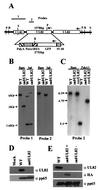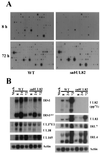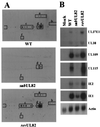UL82 virion protein activates expression of immediate early viral genes in human cytomegalovirus-infected cells
- PMID: 11121054
- PMCID: PMC18949
- DOI: 10.1073/pnas.97.26.14506
UL82 virion protein activates expression of immediate early viral genes in human cytomegalovirus-infected cells
Abstract
The human cytomegalovirus UL82 gene encodes a protein (pp71) that is localized in the tegument domain of the virus particle. The UL82 gene product is delivered to the nucleus at the time of infection, and it is believed to function in gene activation. We have constructed a human cytomegalovirus mutant, ADsubUL82, that lacks a substantial portion of the UL82 coding region. It was propagated on human diploid fibroblasts expressing the UL82 gene product, and it was possible to produce a mutant virus lacking the UL82 protein by passaging virus stocks for one cycle of growth on normal, noncomplementing fibroblasts. The UL82-deficient mutant displays a multiplicity-dependent growth defect in normal human fibroblasts. The growth of ADsubUL82 is severely restricted at low input multiplicities (0.01-0.1 plaque-forming units per cell), producing a yield that is reduced by a factor of about 10(5) in comparison to wild-type virus. At higher input multiplicities (10 plaque-forming units per cell), ADsubUL82 grew nearly as well as the wild-type virus. By using a human cytomegalovirus gene array, we demonstrated that UL82 functions to facilitate virus mRNA accumulation very early during the human cytomegalovirus replication cycle. The growth phenotype associated with the UL82 mutant seems to result from its inability to efficiently activate human cytomegalovirus immediate early genes.
Figures





References
-
- Alford C A, Britt W J. In: Fields Virology. Fields B N, Knipe D M, Howely P M, editors. New York: Lippincott-Raven; 1995. pp. 2493–2543.
-
- Gibson W. Virology. 1981;111:516–537. - PubMed
-
- Gibson W. Virology. 1983;128:391–406. - PubMed
-
- Spaete R R, Gehrz R C, Landini M P. J Gen Virol. 1994;75:3287–3308. - PubMed
Publication types
MeSH terms
Substances
Grants and funding
LinkOut - more resources
Full Text Sources
Other Literature Sources

